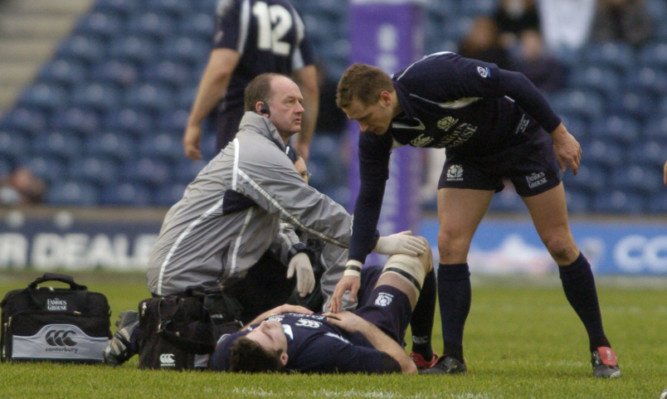Nobody involved in this gruelling Rugby World Cup from players, coaches, right down to administrators and journalists even is exactly having a holiday. But surely no-one is as involved as Dr James Robson.
The former Dundee GP is chiefly Scotland’s chief medical officer, pitchside with his bag attending immediately to whatever bruise or tweak or dazing collision occurs. He’s active on gameday from almost the first moment, taping and patching up players before they go out, watching them all intently for signs of problems through the warm-up, and then in the game itself.
Inbetween games, he’s overseeing recovery, getting scans of injuries, still patching up bodies. He’s the one man in the squad who never gets a day off, and the only man who gives orders to head coach Vern Cotter.
On top of that, Dr Robson’s reputation as the pre-eminent “hands on” medical practioner in rugby, maybe even in world sport multiple Lions’ tours, decades with Scotland, and an authority on issues which have even changed the game means he’s keeping a weather eye on wider issues of player safety at the same time.
Five years ago Dr Robson was awarded a fellowship of the Royal College of Surgeons of Edinburgh a rare accolade for a non-surgeon due to a career in sports medicine which began when he went along to Mayfield just to see if he could help out with the Dundee HSFP rugby club.
After a month of this World Cup, the anecdotal evidence is that there’s more injuries than ever. Just a few hours after we spoke at the Scotland team base in Newcastle, Ireland lost three key players in the first hour of their game against France, but Dr Robson wants to see the cold, hard figures.
“It’s tough to say whether this World Cup is more attritional,” he said. “We’ll only really know when all the stats are collated. The big story is the number of injuries to Wales, but if you use the example of Leigh Halfpenny, his ACL injury could have happened running on his own.
“Touch wood, our only big injury has been Grant Gilchrist who was just unlucky to get a tear in a muscle that wouldn’t heal in a certain timescale. But all our players who took part in the Samoa game have got some sort of niggle today.
“I’m relishing the fact that we’ve got an eight-day turnaround before the quarter-final now. Four games in 17 days was a challenge, but we can front load this week with two days of really quality recovery.”
Dr Robson helped instigate the general move towards greater player safety after the 2009 Lions Tour to South Africa, where the intensity of the contact and collisions began to concern him.
“I thought after the South Africa Lions tour we couldn’t possibly go more physical,” he says. “I just think that evolution can’t catch up, guys can’t get any bigger and still play. But I’m just amazed at the supreme athletic prowess of the guys that we’ve got, and that in itself leads to bigger collisions.
“Whether they’re better conditioned to cope with these collisions is the moot point.”
Changing the rules, and more strictly applying them – as has occurred at the clearout and the tackle during this World Cup – has helped, he adds.
“Undoubtedly if you get good refereeing, you’ll minimise injury, because very quickly teams learn that a yellow card means seven, nine, ten points deficit,” he points out. “And I think the players have to be more aware that the collisions are big enough without it being illegal. So good policing is incredibly important.”
Concussion fears have been the most prominent medical issue in rugby these last 18 months, and Dr Robson believes the protocols in place now cover all bases.
“There is only one boss in that decision and it’s not the player,” he laughs. “I use the same language as the players. If they tell me to f-off on the pitch I simply reply in the same vernacular.
“A good example was recently one of the players did not want to be stretchered off in a warm-up game. I just said to him, ‘That’s fine but if you walk off the pitch, no World Cup’. It makes that much of a difference if you treat correctly and in the end he healed in the requisite time.”
Treating concussed and confused players has other dangers, though.
“Quite often they are more aggressive than normal. I once had a player many years ago take a right hook to me because he thought I was the opposition peering over him,” he continued. “Other times they are crying like a baby or can be very confused.
“There are things that we probably missed 10 years ago that we are now treating as concussion. Are we over-treating? I think not. I think we’re being ultra-cautious because we’re still not sure what the outcomes are.
“Better like Saturday to take Dicko (Alasdair Dickinson) off. He passed his test, he was assessed after the match as well, sailed through that and this morning he is fine.”
Still, in the best traditions of medicine, there are some mysteries that defy even someone of Dr Robson’s vast experience, like Stuart Hogg’s recurring cramp during this World Cup.
“Hoggy’s cramp is doing my head in,” he laughs. “Some people are susceptible to change in surroundings, particularly beds. For others it’s the change in surface from grass to artificial. I’ve even seen a lot of people cramping up because we’re playing on football pitches, which are slightly firmer than the ones we usually play on.
“But Hoggy had one game at Leeds, which was on a football pitch, where he played the whole 80 minutes without cramp, so what was the difference?
“He hasn’t had a problem with it in the past. It’ll probably be one of those things that passes.”
